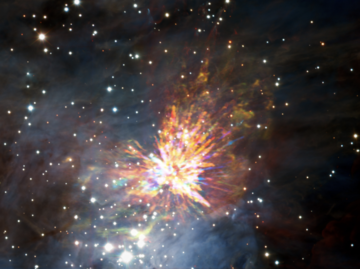According to the Global Hierarchical Collapse (GHC) scenario a molecular cloud should globally collapse and start individual small collapses at its density peaks. Thus the average density of the cloud should increase with time and its Jeans mass should decrease, naturally fragmenting into lower-mass fragments as the cloud evolves. There are hints that this is happening observationally but no clear systematic study has been performed so far. Thus, a great contribution to test the GHC scenario would be to systematically show, using submillimeter high angular resolution images of infrared-quiet clumps, that the less evolved clumps fragment into more massive fragments.

 Es el grupo de radioastrónomos del IRyA y sus estudiantes. Nos reunimos cada 15 días con el objetivo de compartir experiencias, resultados recientes, resúmenes de congresos, etc. La imagen muestra uno de los resultados de los investigadores del grupo, basada en datos del Atacama Large Millimeter/submillimeter Array del flujo explosivo de Orion BN/KL (Bally, Zapata et al. 2017).
Es el grupo de radioastrónomos del IRyA y sus estudiantes. Nos reunimos cada 15 días con el objetivo de compartir experiencias, resultados recientes, resúmenes de congresos, etc. La imagen muestra uno de los resultados de los investigadores del grupo, basada en datos del Atacama Large Millimeter/submillimeter Array del flujo explosivo de Orion BN/KL (Bally, Zapata et al. 2017).